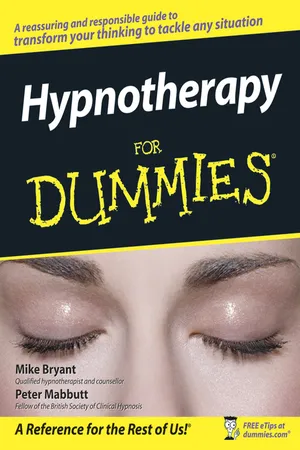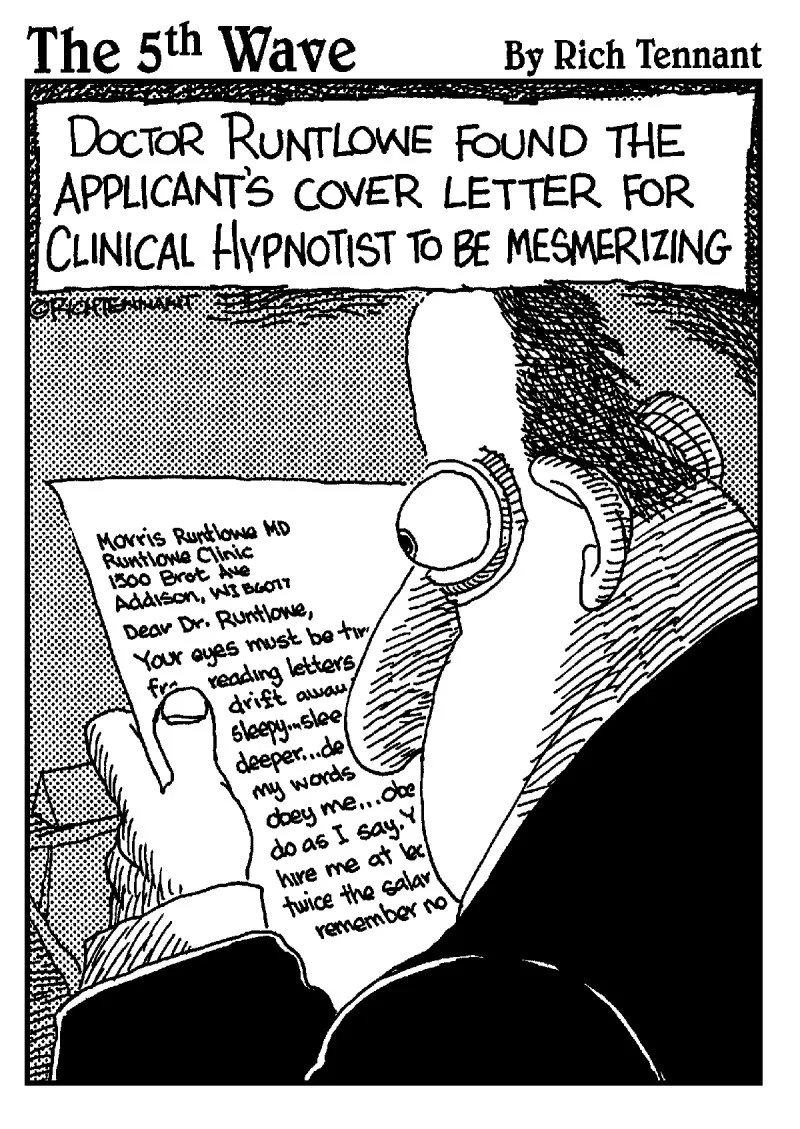
- English
- ePUB (mobile friendly)
- Available on iOS & Android
eBook - ePub
Hypnotherapy For Dummies
About this book
An easy-to-follow, reassuring and responsible guide that shows how you can use hypnotherapy to identify and overcome unhealthy modes of thinking, deal with emotional issues, improve performance, and banish bad habits. Whether you're seeking to overcome anxiety or depression, improve your performance professionally or personally, lose weight or beat an addiction, hypnotherapy can help you make the changes you want.
Frequently asked questions
Yes, you can cancel anytime from the Subscription tab in your account settings on the Perlego website. Your subscription will stay active until the end of your current billing period. Learn how to cancel your subscription.
No, books cannot be downloaded as external files, such as PDFs, for use outside of Perlego. However, you can download books within the Perlego app for offline reading on mobile or tablet. Learn more here.
Perlego offers two plans: Essential and Complete
- Essential is ideal for learners and professionals who enjoy exploring a wide range of subjects. Access the Essential Library with 800,000+ trusted titles and best-sellers across business, personal growth, and the humanities. Includes unlimited reading time and Standard Read Aloud voice.
- Complete: Perfect for advanced learners and researchers needing full, unrestricted access. Unlock 1.4M+ books across hundreds of subjects, including academic and specialized titles. The Complete Plan also includes advanced features like Premium Read Aloud and Research Assistant.
We are an online textbook subscription service, where you can get access to an entire online library for less than the price of a single book per month. With over 1 million books across 1000+ topics, we’ve got you covered! Learn more here.
Look out for the read-aloud symbol on your next book to see if you can listen to it. The read-aloud tool reads text aloud for you, highlighting the text as it is being read. You can pause it, speed it up and slow it down. Learn more here.
Yes! You can use the Perlego app on both iOS or Android devices to read anytime, anywhere — even offline. Perfect for commutes or when you’re on the go.
Please note we cannot support devices running on iOS 13 and Android 7 or earlier. Learn more about using the app.
Please note we cannot support devices running on iOS 13 and Android 7 or earlier. Learn more about using the app.
Yes, you can access Hypnotherapy For Dummies by Mike Bryant,Peter Mabbutt in PDF and/or ePUB format, as well as other popular books in Psychology & Hypnotism. We have over one million books available in our catalogue for you to explore.
Information
Part I
Understanding Hypnotherapy

In this part . . .
You find some helpful background information in this part to help you to understand how hypnotherapy works. This part also looks at the terms used in hypnotherapy, the basics of how it works, and what hypnotherapy is used for. You even find a very brief history of hypnosis and hypnotherapy included in this part.
If you want to know exactly what a hypnotherapist does, we describe the techniques and procedures used in a typical hypnotherapy session. In other words, this part is a great place to start if you’re new to hypnotherapy.
Chapter 1
Examining Hypnotherapy
In This Chapter




Hypnosis is a powerful technique. It can help you change negative beliefs and achieve your goals, treat serious emotional problems, and alleviate a range of medical conditions.
You may hear about a work colleague who was cured of smoking in a single session, or a friend of a friend whose lifelong phobia was permanently removed by a hypnotherapist. A hypnotherapist can also show you how to practise self-hypnosis in order to achieve a seemingly infinite variety of personal goals.
This chapter explains what hypnosis and hypnotherapy are about. It gives you a clear understanding of what is involved, the difference between hypnosis and hypnotherapy, and some of the amazing benefits possible.
Getting to Grips with the Basics of Hypnotherapy
First things first. We want to reassure you right up front that hypnosis is safe.

When you’re in a hypnotic trance, you are completely aware of the words being spoken to you by the hypnotherapist. And, should a fire alarm go off – or any other physically threatening situation arise – you will immediately take yourself out of trance to respond.
Hypnosis carries an element of risk as do all therapies and activities. But, as long as your hypnotherapist is properly qualified, and operates within a professional code of conduct and ethics (which we discuss in Chapter 12), you needn’t worry.
In the following subsections, we sort out the jargon and the basic terms used in hypnotherapy.
Discovering the differences between hypnosis and hypnotherapy
The first useful thing to distinguish is the difference between hypnosis and hypnotherapy. We really want you to understand that there is a big difference between the act of hypnotising someone (hypnosis) and the amazing changes that can happen with the help of a qualified hypnotherapist (hypnotherapy). We hope that after you read this section you will never confuse a stage hypnotist (the person you see getting laughs on TV) with a hypnotherapist (the person who helps you stop smoking, lose weight, or recover from a life-long phobia).

Hypnosis can be likened to the state you are in when you act intuitively instead of intellectually. During hypnosis, you basically ask your inner drill sergeant to take a break while your clever, artistic self comes forward. And believe us, everybody has both aspects within them!


Stage hypnosis is not hypnotherapy
Stage hypnosis is a form of entertainment. It is not a way to receive help for your problems or to achieve your aspirations. We do not recommend that you become personally involved in stage hypnosis as there is no personal care for your individual needs. It’s a stage act where the main aim is to get laughs – at your expense if you get on stage!
Many, many people get involved in stage hypnosis with no bad after-effects. However, some former stage participants have suffered emotional problems afterwards. This is an area of great debate as to whether these people were already predisposed to emotional problems, or if stage hypnosis had a negative influence.
An interesting book that involves a critical look at stage hypnosis is Investigating Stage Hypnosis by Tracie O’Keefe and Katrina Fox (Extraordinary People Press).
Sliding into trance
Trance is a state of mind that involves a selective focus of attention. You are in a natural trance state several times each day, usually when you’re relaxing.
Examples of times you may slip into a trance include:






Trance states occur naturally and regularly. Hypnosis utilises these states to access your unconscious mind (see the next section) in order to help you more easily achieve your goal or solve your problem.
The following are the main trance states, and some of the traits a hypnotised person may experience while in each state, listed from light to deep levels:




Table of contents
- Title
- Contents
- Introduction
- Part I : Understanding Hypnotherapy
- Part II : Considering How Hypnotherapy Can Help
- Part III : Expanding the Reach of Hypnotherapy
- Part IV : The Practical Stuff
- Part V : The Part of Tens
- : Further Reading